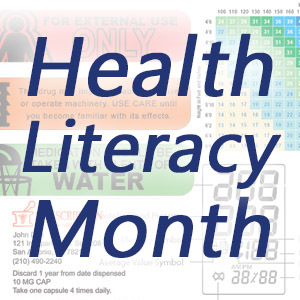
Health literacy is defined as “the degree to which individuals have the capacity to obtain, process and understand basic health information and services needed to make appropriate health decisions.” (Healthy People 2010)
Even those with strong literacy skills can have difficulty interpreting health information, especially when they must understand numbers or risks to make a decision about their own health. Research suggests that 90 million American adults have trouble comprehending and acting upon health information.
In honor of Health Literacy Month, this article aims to educate those who may find medical information confusing or unfamiliar by going over the meaning of vital signs and other items that one may find on their prescriptions and personal medical reports.
B.M.I.
BMI stands for body mass index, and it is a measure of the relationship between an individual’s height and weight. It has some limitations, as it does not consider the percentage of body fat, but it is often a reliable way to determine how much one’s weight differs from what is considered normal for their height.
The threshold for overweight and obese is subject to debate, but overweight (more body fat than is optimal for good health) is generally defined at around 25-30. Obese (excess body fat that may affect one’s health) can be anywhere from 30 to over 40 on the BMI scale. Normal is generally considered to be from 18.5 to 25, and anything below 18.5 is underweight.
Below is a calculator from the CDC that can help you find out your exact BMI number and learn more about the steps to take to keep it in a normal range.
Blood Pressure
Blood pressure readings come in two numbers, and are written as a ratio with one number over the other.
The top number is a measurement of the pressure in the arteries when the heart beats, called systolic blood pressure. A normal systolic blood pressure can range from 100-140.
The bottom number is a measurement of the pressure in the arteries in between heart beats, called diastolic blood pressure. A normal diastolic blood pressure reading can range from 60-90.
A normal reading for blood pressure might look something like this: 120/80 mm Hg
The main risk of high blood pressure is called hypertension. Hypertension strains the heart, and can lead to heart and kidney disease if not properly treated. It also puts you at increased risk for stroke and lower life expectancy.
If you reading is higher than the normal blood pressure range, it does not necessarily mean you have hypertension. Your doctor may take additional readings as time goes by or ask you to monitor your own blood pressure before a diagnosis (a proper identification of the disease) is made.
Below is a chart from the American Heart Association that shows the categories of blood pressure readings and what they may indicate.
| Blood Pressure Category | Systolic mm Hg (upper #) | Diastolic mm Hg (lower #) | |
| Normal | less than 120 | less than 80 | |
| Prehypertension | 120 – 139 | 80 – 89 | |
| Hypertension Stage 1 | 140 – 159 | 90 – 99 | |
| Hypertension Stage 2 | 160 or higher | 100 or higher | |
| Hypertensive Crisis (Emergency care needed) | Higher than 180 | Higher than 110 |
Low blood pressure is generally not as much of a concern. If your blood pressure reading falls below normal, it could be due to several factors, such as pregnancy, medications, allergic reactions or vitamin deficiencies, among other things.
Low blood pressure is only a cause for concern if it results in symptoms such as dizziness, fainting, dehydration, blurred vision, shallow breathing, and fatigue.
Drug Labeling and Medical Instructions
Drug labeling is one of the main concerns of health literacy experts. Warning labels, the small, colorful stickers that are often added to prescription bottles are being proven as difficult to interpret and act upon.
A 2006 study found that 1/3 of adult patients receiving primary care at public hospital clinics were reading at or under the 6th-grade level, which is considered low literacy. These patients had problems understanding prescription warning labels. Patients across all literacy levels had problems understanding multiple-step instructions on warning labels, as opposed to single-step instructions.
Warning labels are not standardized or regulated, and are created by multiple companies and pharmacy chains with no consumer involvement. This has resulted in poor message clarity, random use of color and confusing icons.
Although they can be helpful, it is important not to rely on warning labels to take medications safely. If you are unsure about how to properly take your medication, you should contact your primary care physician for clarification. In fact, much of the responsibility falls on healthcare providers to have discussions with patients to verify that they can describe and demonstrate how to take their medications. Handing out simple written instructions with jargon-free language, rather than relying on prescription bottles, can be an effective step towards ensuring that patients take their medications safely and effectively.
Speaking and listening carefully, having open communication with your doctor and restating information in your own words are also great techniques for making sure you don’t misinterpret any instructions and that you fully understand your doctor’s orders.
